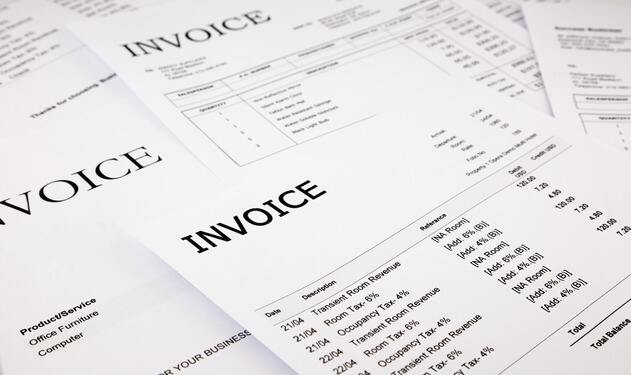How to Write an Invoice for Construction Work (with Free Template)
When you’re a business owner, getting paid on time is as important as the products or services you deliver. Cash is the lifeblood of business, and without it, you can’t keep operating. Even one late payment can mean disaster for a small company.
A solid invoicing process is the lifesaver your contractor business needs. Timely, professional invoices show clients that you’re reliable and take projects seriously. This can lead to more sales and a stronger reputation.
To perfect your billing process, you need to have a simple invoice template to follow, from the formatting to the wording. Here, we’ll look at some invoice description examples to help you choose the best one for your business.
What Should An Invoice Include?
The information you include on your invoice helps you and your client keep track of payments, deadlines, and project progress. The type of service you provide may affect some parts of the invoice, but every invoice should include the following:
- Date. This is the day you send the invoice to your client.
- Logo. Adding your logo to the invoice makes your business look professional and consistent. Place your logo where the client can easily see who the invoice is from.
- Business name and address. Along with the logo, include your business name and contact information. This helps your client know who to contact if they have questions or where to send payment by mail.
- Client’s billing information. Include your customer’s information to track which project the invoice is for and keep an organized billing history.
- Invoice number. Each invoice should have a unique number. This helps you stay organized when managing your finances, especially during tax season.
- List of services or products. List exactly what you provided to the client. This helps you track your work and understand what the client may need in the future.
- Payment terms and due date. State how and when the client should pay. Include any taxes or discounts to avoid confusion about the total amount.
FROM ONE OF OUR PARTNERS — How to Send an Invoice
5 Invoice Example Templates

Now you know the key details every invoice should include, let’s explore how the type of service you provide can change what you put on your invoice. Here are five invoice examples to help guide you:
1. How to Make a Painting Invoice
As a painter, a clear and simple invoice helps your clients understand what they’re paying for, avoiding confusion when the job is done. Painting invoices include details like:
- List of Work. Include the tasks you completed, such as interior painting, wall preparation, or trim work.
- Materials Used. List the type of paint and materials, like brushes or drop cloths.
- Labor Costs. Say whether you charge by the hour or offer a flat rate for the entire job.
- Payment Terms and Due Date. Let your client know when the payment is due and how they can pay (bank transfer, check, etc.).
Tip to Make Your Invoice Stand Out. Include a small before-and-after photo of the painted area when sending your invoice. Either include a printed copy or send it by email. This not only shows the work you’ve done but also personalizes the invoice, making it unique for each client.
RELATED ARTICLE — Free Painting Invoice Template and Tips
2. How to Make a Plumbing Invoice
For plumbers, a straightforward invoice outlines what was done and why it was necessary. Providing detailed information helps clients understand the work so you get paid without a hitch. A plumber’s invoice should include:
- Services Provided. List each task, such as repairing a leaky pipe, installing a new sink, or replacing faucets. Specify if the job was routine maintenance, a new installation, or an emergency fix.
- Parts Used. Include all parts, like pipes, valves, or fittings.
- Inspection or Diagnostic Fees. If you performed an inspection or diagnostics before the repair, mention it here.
- Emergency or After-Hours Fees. If there were extra charges for urgent work or after-hours service, mention this.
- Payment Details. Outline the total cost, including labor, parts, and additional fees. Provide payment instructions.
Tip to Make Your Invoice Stand Out. Add a short maintenance tip at the bottom, such as “To prevent future clogs, avoid pouring grease down the drain.” Adding this small feature shows you care about helping the client and adds extra value to your service.
RELATED ARTICLE — How to Write an HVAC Invoice (with Free Invoice Template)
3. How to Make a Landscaping Invoice
In landscaping, clients need to know what services were completed and how those services improve their outdoor space. A strong invoice shows that you and your client are on the same page. Landscaping invoices should focus on:
- Services. Highlight your landscaping services, such as lawn mowing, garden design, or tree trimming. If the job includes many visits or ongoing maintenance, specify those details.
- Materials and Plants Used. If you planted trees, shrubs, or laid down mulch or sod, list these materials. Clients like knowing exactly what was used to improve their landscape.
- Project Timeline. Include start and end dates for the project. If the work needs follow-up visits or maintenance, explain when you’ll return to the site.
- Seasonal or One-Time Services. Specify if the services were part of a seasonal package (e.g., winterizing a garden) or a one-time job like installing a patio or water feature.
- Payment Breakdown. Include the total cost of labor, materials, and any more fees. Provide payment instructions and the due date.
Tip to Make Your Invoice Stand Out. Add a seasonal care tip at the bottom, such as “Water your newly planted shrubs twice a week for the next month to help them establish.” This advice shows your commitment to the client’s long-term satisfaction.
4. How to Make a General Contractor Invoice
As a general contractor, your invoice must cover a wide range of services and tasks. Good communication is key to helping your clients understand the full scope of the project and the costs involved. There are many different contractor invoice examples, but here’s what to include if you are a general contractor:
- Project Summary. Provide a brief overview of the project, such as “Home renovation” or “Office remodel.”
- List of Subcontractors and Services. Break down the work done by each subcontractor (e.g., electricians, plumbers, carpenters). Include the tasks completed, such as wiring installation, plumbing repairs, or flooring.
- Phased Payments and Milestones. If the project is large and paid in phases, list the completed stages (e.g., framing, roofing) and how much is due for each milestone.
- Material Costs. List materials such as lumber, concrete, or drywall. Separate the materials by phase for large projects, such as framing or finishing.
- Labor and Management Fees. List fees for overseeing the project, managing the subcontractors, and coordinating the work schedule.
- Final Payment and Due Date. Make clear how much is still owed, what has already been paid, and when the final payment is due. Include the payment method options.
Tip to Make Your Invoice Stand Out. Add a timeline at the bottom of the invoice, such as “Finished in 5 weeks, despite originally quoting 7.” This helps clients see how you went above and beyond to meet their expectations.
5. How to Make a Contractor Invoice
As a contractor, your invoice should outline your services and the time spent on each task. A simple, well-organized invoice provides smooth communication with your clients, encouraging timely payments. Here’s what to focus on:
- Service Description. Summarize the tasks or projects you completed, such as rewiring a house, installing a sink, or cleaning an HVAC system.
- Hourly or Flat Rate. Explain whether you charge by the hour or for the entire project. Include the number of hours worked and the total hourly rate or the total project cost.
- Project Outcomes. List the final product (e.g., “New kitchen sink installed” or “Ducts cleaned and inspected”) to provide a record of what was completed.
- Extra Work. If you provided any extra services outside of the original agreement, list them and mention the added costs.
- Payment Terms and Method. Include the total amount due, when it’s due, and how the client can pay.
Tip to Make Your Invoice Stand Out. Add a personalized thank-you note at the bottom, such as “Thank you for the opportunity to work together! I look forward to future projects.” This small personal touch helps build long-term client relationships.
RELATED ARTICLE — How to Write an Invoice for Construction Work (with Free Template)
Benefits of Invoices

Using detailed invoices shows clients that you are reliable and legit. It helps them understand what they’re paying for and shows you take your business seriously.bebe
Invoices also keep your work organized and provide a record of your completed projects and payments. You can track receipts, overdue payments, or any unpaid invoices. All of this is important for tax purposes and can protect you in case of any legal disputes.
FROM ONE OF OUR PARTNERS — The 9 Essential Elements of a Small Business Invoice
3 Tips to Manage Invoicing Like a Pro
Managing invoice payment correctly helps you get paid on time and keeps business running smoothly. Here are three easy tips to stay on top of your invoicing:
- Set payment reminders. Send friendly reminders to clients before the due date to avoid late payments.
- Track payments. Keep a record of every payment you get to stay organized.
- Offer many payment methods. Accepting different payment options like bank transfers, credit cards, or mobile payments makes it easy for clients.
FROM ONE OF OUR PARTNERS — A Guide to Common Types of Invoices and Price Quotes
Send professional invoices to your customers
Now you know the types of invoices for different services, it’s time to simplify your invoicing process. With Joist, it’s easier than ever.
Our easy-to-use mobile invoicing tool allows you to create and send professional invoices to your customers in minutes. You can also track payments, send reminders, and manage your monthly sales—all from one place.